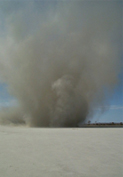
Dust in El Mirage
A dust devil in El Mirage Lake, a dry lake bed in the Mojave in San Bernardino County. El Mirage is a popular site for ORV enthusiasts.
Dust Emission
The storage, release, and transport of dust play significant roles in ecosystem processes.1 Some dust particles that carry soil nutrients and organic matter are small enough to travel long distances, up to hundreds of kilometers in one wind event, before settling.2,3 Dust from the Mojave Desert has been documented in areas as far west as California’s Channel Islands, and as far east as the Colorado Plateau.4 Wind erosion and dust emission therefore play a role in nutrient cycling across landscapes and ecosystems, both terrestrial and aquatic.
In addition to influencing ecosystems, dust emission can negatively affect human health through particulate matter (PM10) pollution (particulate matter that is less than 10 microns in diameter). The U.S. Environmental Protection Agency (EPA) lists effects on breathing and respiratory systems, damage to lung tissue, cancer, and premature death as the major concerns for human health from exposure to PM10 air pollution.5 The EPA warns that the elderly, children, and people with chronic lung disease, influenza, or asthma, are especially sensitive to the effects of particulate matter.6
The contribution of windblown dust to PM10 air pollution has been well-studied in relation to Owen’s (dry) Lake, California. Windblown dust erosion off of the dry lake bed can cause 24-hour average PM10 concentrations of over 12,000 μg m−3, far exceeding federal air quality standards that require PM10 concentrations to be below 150 μg m−3. 7
Three Controls of Dust Emission in the Desert
1. Soil moisture binds soil particles together, making the surface more resistant to erosion.8 Higher temperatures due to climate change could lead to increased evaporation and decreased precipitation, which may boost dust emission from California’s desert regions.
2. Soil crusts help buffer the effects of wind erosion. Studies indicate that lichen and moss biological soil crusts are the most resistant of desert soil types to wind erosion.9
3. The presence of vegetation across a potential dust source area can also act as a control for emissions. Plants act as a protective cover and inhibit wind erosion by decreasing the amount of wind that reaches the soil surface. As plant cover decreases, and unvegetated gaps increase in size and the soil surface becomes more vulnerable to erosion and soil loss.10 Drier and hotter conditions due to climate change may reduce plant cover and erosion resistance.
1 J.P. Field, J. Belnap, D.D. Breshears, J.C. Neff, G.S. Okin, J.J. Whicker, T.H. Painter, S. Ravi, M.C. Reheis, R.L. Reynolds, “The ecology of dust,” Frontiers in Ecology and the Environment, The Ecological Society of America, 2009.
2 R. Reynolds, J. Belnap, M. Reheis, P. Lamothe, F. Luiszer, “Aeolian dust in Colorado Plateau soils: Nutrient inputs and recent change in source,” Proceedings of the National Academy of Sciences of the United States of America, 98, no. 13 (2001): 7123- 7127.
3 J.P. Field, J. Belnap, D.D. Breshears, J.C. Neff, G.S. Okin, J.J. Whicker, T.H. Painter, S. Ravi, M.C. Reheis, R.L. Reynolds, “The ecology of dust,” Frontiers in Ecology and the Environment, The Ecological Society of America, 2009.
4 R. Reynolds, J. Belnap, M. Reheis, P. Lamothe, F. Luiszer, “Aeolian dust in Colorado Plateau soils: Nutrient inputs and recent change in source,” Proceedings of the National Academy of Sciences of the United States of America, 98, no. 13 (2001): 7123- 7127.
5 Environmental Protection Agency, Particulate Matter (PM-10), 1995, AIRTrends 1995 Summary, http://www.epa.gov/airtrends/aqtrnd95/pm10.html.
6 Environmental Protection Agency, Particulate Matter (PM-10), 1995, AIRTrends 1995 Summary, http://www.epa.gov/airtrends/aqtrnd95/pm10.html.
7 D. Gillette, D. Ono, and K. Richmond, “A combined modeling and measurement technique for estimating windblown dust emissions at Owens (dry) Lake, California,” Journal of Geophysical Research 109 (2004): F01003.
8 J.P. Field, J. Belnap, D.D. Breshears, J.C. Neff, G.S. Okin, J.J. Whicker, T.H. Painter, S. Ravi, M.C. Reheis, R.L. Reynolds, “The ecology of dust,” Frontiers in Ecology and the Environment, The Ecological Society of America, 2009.
9 Jayne Belnap, “Biological Soil Crusts and Wind Erosion,” in Biological Soil Crusts: Structure, Function, and Management, eds. J. Belnap and O.L. Lange, Ecological Studies, Vol. 150 (Berlin Heidelberg: Springer-Verlag, 2001).
10 J.P. Field, J. Belnap, D.D. Breshears, J.C. Neff, G.S. Okin, J.J. Whicker, T.H. Painter, S. Ravi, M.C. Reheis, R.L. Reynolds, “The ecology of dust,” Frontiers in Ecology and the Environment, The Ecological Society of America, 2009.
